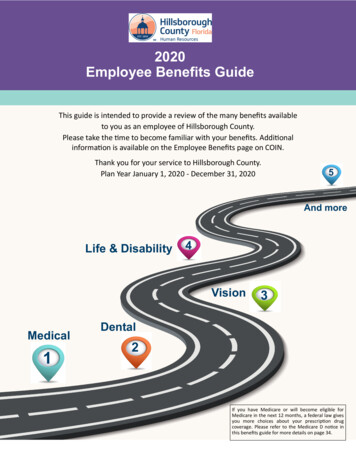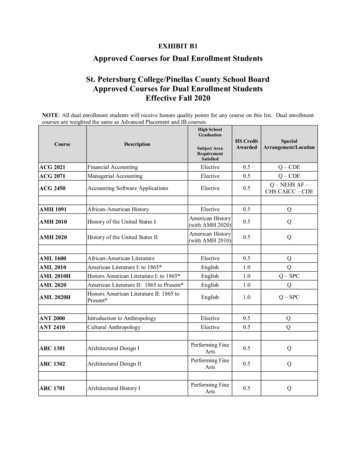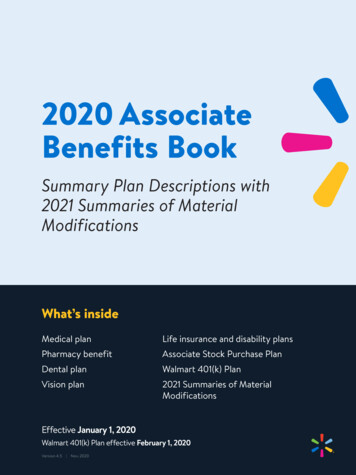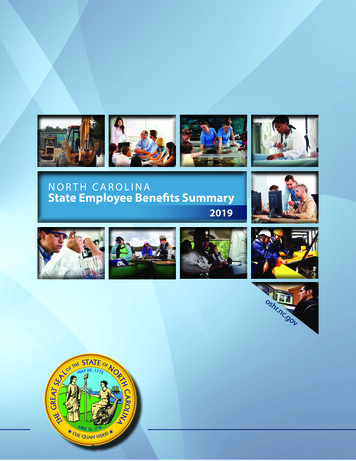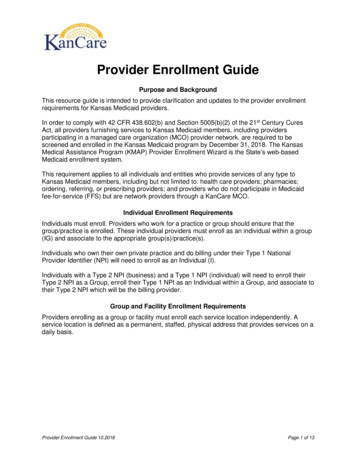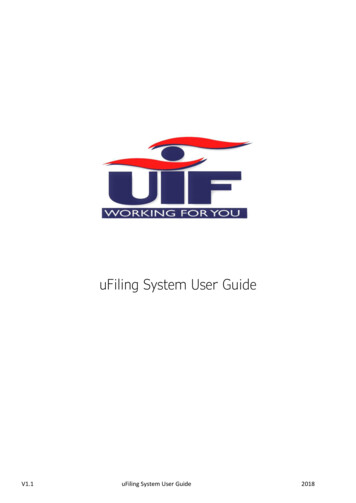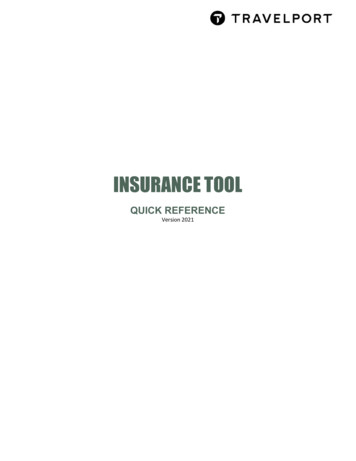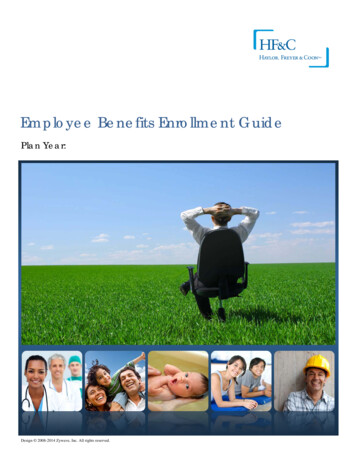
Transcription
Employee Benefits Enrollment GuidePlan Year:Design 2008-2014 Zywave, Inc. All rights reserved.
Welcome to OpenEnrollment for yourBenefits!(sample text)Elections you make during open enrollment will become effective (insert date).offers you and your eligible family members a comprehensive and valuable benefits program. Weencourage you to take the time to educate yourself about your options and choose the bestcoverage for you and your family.
Who is Eligible?(sample text) If you are a full-time employee (working 30 or morehours per week) you are eligible to enroll in the benefits described inthis guide. The following family members are eligible for medical,dental and vision coverage: [Insert dependent coverageinformation].How to Enroll(sample text) The first step is to review your current benefitelections. Verify your personal information and make any changes ifnecessary. Make your benefit elections. Once you have made yourelections, you will not be able to change them until the next openenrollment period unless you have a qualified change in status.When to Enroll(sample text) The open enrollment period runs from [insert date]through [insert date]. The benefits you elect during open enrollmentwill be effective from [insert date] through [insert date].How to Make Changes(sample text) Unless you have a qualified change in status, youcannot make changes to the benefits you elect until the next openenrollment period. Qualified changes in status include: marriage,divorce, legal separation, domestic partnership status change, birthor adoption of a child, change in child’s dependent status, death ofspouse, child or other qualified dependent, change in residence dueto an employment transfer for you, your spouse or domestic partner,commencement or termination of adoption proceedings, or changein spouse’s or domestic partner’s benefits or employment status.
What’s New for[Insert major changes for this year.] Medical Dental Vision201X
Medical and Prescription Drugs(sample text) Several changes have been implemented to our medical and prescription drug benefitsfor the upcoming plan year Jan. 1 to Dec. 31, 201X. Our HMO plan no longer requires you to select aprimary care physician or secure a referral from one provider to another. As a reminder, the plan doesnot provide coverage when you use out-of-network providers. Our PPO plan allows you the freedomto use providers in and out-of-network. The following chart compares our current benefits to the newbenefits that will take effect Jan. 1, 201X.HMOServicesCurrentPPOAs of Jan.1,201XCurrentAs of Jan. 1,201XPhysician VisitDeductible- Individual- FamilyHospitalizationPreventive CareEmergency RoomOut-of-Pocket Max- Individual- FamilyPrescription Drugs- Retail/Mail Order- Generic- Preferred- Non-PreferredYour Cost in 201X(sample text) is pleased to announce there will be no premium increase passed on to you for the newplan year. Bi-weekly payroll deductions will remain as shown.EMPLOYEE BI-WEEKLY DEDUCTIONSEmployee OnlyEmployee & SpouseEmployee & ChildrenEmployee & FamilyHMO PPO
Dental(Sample text) There are no plan or cost changes to your dental benefits or cost in 201X. ’s planallows you to seek treatment from the dentist of your choice.ServicesAmount You PayPreventiveServicesExams, cleanings, x-rays – [insert benefit amount or coinsurance]DeductibleApplies to basic and major services only – [insert benefit amount or coinsurance]Basic ServicesFillings, simple extractions – [insert benefit amount or coinsurance]Major ServicesOral surgery, root canal, crowns – [insert benefit amount or coinsurance]Annual Maximum[insert annual maximum amount]Bi-WeeklyDeductionEmployee only – Employee & Spouse – Employee & Child – Family –
Vision(Sample text) When you are enrolled in our medical plan you also receive vision benefits. If you utilizethe services of a provider listed in the Preferred Provider Directory, your benefits include routinevision exams for a 25 copay, and preferred pricing on a large selection of brand-name, designerframes, lenses, and lens options.
Disability Income Benefits(Sample text) provides full-time employees with short and long-term disability income benefits, and pays thefull cost of this coverage. In the event you become disabled from a non work-related injury or sickness,disability income benefits are provided as a source of income. You are not eligible to receive short-termdisability benefits if you are receiving workers’ compensation benefits.Short-term DisabilityBenefits BeginBenefits PayablePercentage of IncomeReplacedMaximum BenefitLong-term Disability
Basic Life Insurance(Sample text) provides full-time employees with 15,000 group life and accidental death and dismemberment(AD&D) insurance, and pays the full cost of this benefit. Contact Human Resources to update your beneficiary.Voluntary Life Insurance(Sample text) Employees who want to supplement their group life insurance benefits may purchase additionalcoverage. When you enroll yourself and/or your dependents in this benefit, you pay the full cost through biweekly payroll deductions. You can purchase coverage on yourself and your spouse in 10,000 increments.Minimum coverage is 20,000 and maximum coverage is 300,000.Monthly Cost for Each 1,000 of Employee & Spouse Life Insurance CoverageAge 3030-3435-39LifeAD&DDependentChildren[Describe benefit & monthly cost]40-4445-4950-5455-5960-6465-6970
Health Care and Dependent Care Flexible Spending Accounts(Sample text) provides you the opportunity to pay for out-of-pocket medical, dental, vision anddependent care expenses with pre-tax dollars through Flexible Spending Accounts. You mustenroll/re-enroll in the plan to participate for the plan year Jan. 1 to Dec. 31, 201X. You can saveapproximately 25 percent of each dollar spent on these expenses when you participate in a FSA.A health care FSA is used to reimburse out-of-pocket medical expenses incurred by you and yourdependents. A dependent care FSA is used to reimburse expenses related to care of eligibledependents while you and your spouse work.Contributions to your FSA come out of your paycheck before any taxes are taken out. This meansthat you don’t pay federal income tax, Social Security taxes, or state and local income taxes on theportion of your paycheck you contribute to your FSA. You should contribute the amount of money youexpect to pay out of pocket for eligible expenses for the plan period. If you do not use the money youcontributed it will not be refunded to you or carried forward to a future plan year. This is the use-it-orlose-it rule.The maximum that you can contribute to the Health Care Flexible Spending account is set by youremployer.The maximum that you can contribute to the Dependent Care Flexible Spending Account is 5,000 ifyou are a single employee or married filing jointly, or 2,500 if you are married and filing separately.The following example shows how you can save money with a flexible spending account.Bob and Jane’s combined gross income is 30,000. They have two children and file their income taxes jointly. Since Bob and Janeexpect to spend 2,000 in adult orthodontia and 3,300 for day care next plan year, they decide to direct a total of 5,300 into theirFSAs.Without FSAsWith FSAs 30,000 e-900**-750**FICA-2,295-1,913After-tax earnings:24,25520,314Gross income:FSA contributions:Gross income:Estimated taxes:Eligible out-of-pocketMedical and dependent care expenses:Remaining spendable income:Spendable income increase:-5,0000 19,255 20,561 1,306*Assumes standard deductions and four exemptions.** Varies, assume 3percent.The example above is for illustrative purposes only. Every situation varies and we recommend that you consult a tax advisor for all tax advice.
Health Savings Accounts (HSA)(sample text) If you participate in the high-deductible health plan, you can set aside money in aHealth Savings Account (HSA) before taxes are deducted to pay for eligible medical, dental andvision expenses. An HSA is similar to a flexible spending account in that you are eligible to pay forhealth care expenses with pre-tax dollars. There are several advantages of an HSA. For instance,money in an HSA can be invested much like 401(k) funds are invested. Unused money in an HSAaccount is not forfeited at the end of the year and is carried forward. Also, your HSA account is yoursto keep which means that you can take it with you if you change jobs or retire. If you have any moneyremaining in your HSA after your retirement, you may withdraw the money as cash.The maximum amount that you can contribute to a HSA in 2015 is 3,350 for individual coverage and 6,650 for family coverage. Additionally, if you are age 55 or older, you may make an additional“catch-up” contribution of 1,000.
Additional Benefit OfferingsAs a employee, you also receive the following benefits paid for by the company:(list additional employer-paid benefits here)You are also eligible to enroll or participate in the following voluntary programs:(list voluntary programs here)The information in this Enrollment Guide is presented for illustrative purposes and is based oninformation provided by the employer. The text contained in this Guide was taken from varioussummary plan descriptions and benefit information. While every effort was taken to accurately reportyour benefits, discrepancies or errors are always possible. In case of discrepancy between the Guideand the actual plan documents the actual plan documents will prevail. All information is confidential,pursuant to the Health Insurance Portability and Accountability Act of 1996. If you have any questionsabout your Guide, contact Human Resources.
Questions & AnswersChanges that can be made effective Jan. 1, 201X: (Sample text) Change medical plans (i.e., HMO to PPO, or PPO to HMO) Enroll or terminate individual and/or dependent coverage in the medical/dental plans Enroll in the Flexible Spending Account Plan Enroll in the Pre-Tax Insurance Premium Plan Add or make changes to the Voluntary Life and AD&D planForms to be completed if making changes: (Sample text) Medical & Dental Enrollment/Change Form to change medical plans or individual/dependentcoverage levels in the medical/dental plans. Voluntary Life and AD&D Enrollment and/or Medical Underwriting Form.What Forms MUST be completed?(Sample text) Flexible Spending Account Enrollment Form/Direct Deposit Form to enroll, re-enroll, orwaive enrollment for the new plan year Jan. 1 to Dec. 31, 201X. The Pre-Tax Insurance Form must be completed by everyone. You must elect to participate tocontinue having your medical and dental premiums withheld on a pre-tax basis Where do I find these forms? (Sample text) Contact Human Resources for all forms.When are the forms due and w here do I return them? (Sample text) All forms are due by [insert due date] and must be returned to HumanResources.Who do I contact with questions? (Sample text) Contact Human Resources with any questions you may have.Other Information: (Sample text) New elections must be made to the Flexible Spending Account to continue participation. If you do not make changes to your current medical and dental elections, those elections willremain the same for the plan year Jan. 1 to Dec. 31, 201X.Benefit MeetingsDateTimeLocation
Enrollment for your Benefits! (sample text) Elections you make during open enrollment will become effective (insert date). offers you and your eligible family members a comprehensive and valuable benefits program. We encourage you to take the time to educate yourself about your opti

